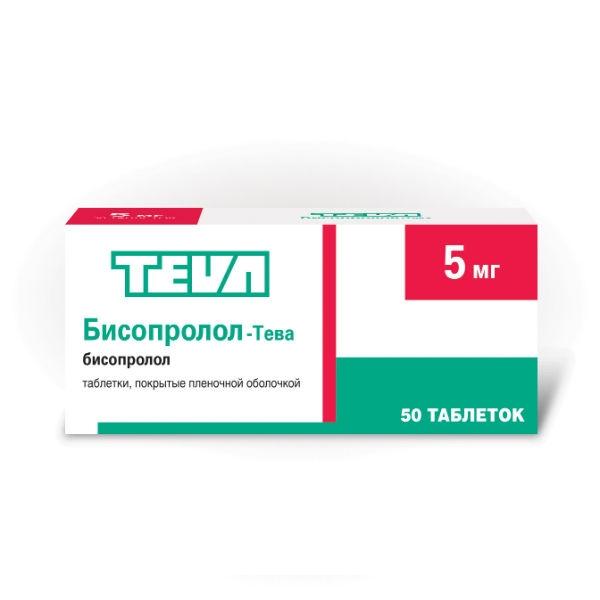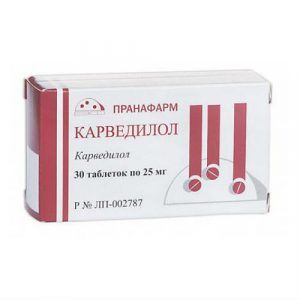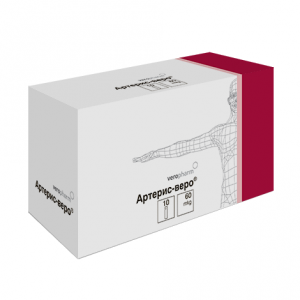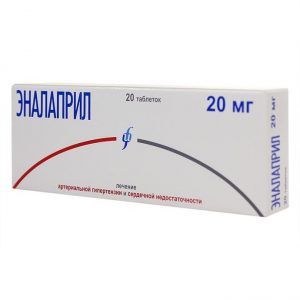Description
Packing
50 pcs.
Pharmacological action
Bisoprolol-Teva has an antianginal, antiarrhythmic, hypotensive effect.
Contraindications
Hypersensitivity, sinus bradycardia (less than 45-50 beats / min), sinus node syndrome, sinoatrial and AV block II ² III degree, cardiogenic shock, acute and refractory to treatment severe heart failure, myocardial infarction, acute hypotension (SBP below 90 mm Hg), severe obstructive respiratory failure, pregnancy, lactation.
Use during pregnancy and lactation
It is possible if the expected effect of the therapy on the mother outweighs the potential risk to the fetus and the baby (there were no adequate and strictly controlled studies on the safety of pregnant and lactating women). Since there is a risk of developing bradycardia, hypotension, hypoglycemia, and respiratory distress (neonatal asphyxia) in newborns, treatment with bisoprolol fumarate should be discontinued 48 72 hours before delivery. If this is not possible, the newborn should be under close medical supervision for 48 72 hours after birth. The secretion of bisoprolol fumarate with breast milk has not been studied, but since it is secreted into breast milk in rats (less than 2%), infants should be under medical supervision.
Special instructions
Test results may be changed during laboratory testing.
Composition
1 tablet contains bisoprolol fumarate 5 mg excipients: croscarmellose sodium (primellose), povidone (polyvinylpyrrolidone medium molecular weight), pregelatinized starch (starch 1500), silicon dioxide colloidal aerosol, aerosol microcrystalline cellulose, lactose (milk sugar), magnesium stearate film composition: Opadry II (polyvinyl alcohol, partially hydrolyzed, titanium dioxide, talc, macrogol (polyethylene glycol 3350), iron dye oxide (II)).
Dosage and administration of
Bisoprolol-Teva is taken orally, without chewing, with a small amount of liquid, in the morning on an empty stomach or during breakfast 1.25-10 mg once a day. The dosing regimen is individual, the dose is increased under the control of blood pressure and pulse. Arterial hypertension and angina pectoris: 5 10 mg mild arterial hypertension (dAD less than 105 mm Hg): 2.5 mg chronic heart failure: 1.25 mg / day (for 1 week), then with good tolerance the dose increase to 2.5 mg / day (1 week), 3.75 mg / day (1 week), 5 mg / day (4 weeks), 7.5 mg / day (4 weeks), then 10 mg / day (target dose). The maximum daily dose for adults is 20 mg.
Side effects
The frequency of side effects is indicated with doses not exceeding 40 mg.
From the side of the nervous system and sensory organs: dizziness (3.5%), insomnia (2.5%), asthenia (1.5%), hypesthesia (1.5%), depression (0.2%), drowsiness , anxiety, paresthesia (feeling cold in the extremities), hallucinations, impaired thinking, concentration, orientation in time and space, balance, emotional lability, tinnitus, conjunctivitis, visual disturbances, decreased secretion of lacrimal fluid, convulsions.
From the cardiovascular system and blood (hematopoiesis, hemostasis): bradycardia (0.5%), arrhythmia, palpitations, AV block, hypotension, heart failure, impaired microcirculation in the myocardium and limbs, intermittent claudication, vasculitis, agranulocytosis, thrombocytopenia, thrombocytopenic purpura.
From the digestive tract: diarrhea (3.5%), nausea (2.2%), vomiting (1.5%), dry mouth (1.3%), dyspeptic symptoms, constipation, ischemic colitis, mesenteric thrombosis arteries.
Respiratory system: cough (2.5%), shortness of breath (1.5%), bronchus and laryngospasm, pharyngitis (2.2%), rhinitis (4%), sinusitis (2.2%), infections respiratory tract (5%), respiratory distress syndrome.
From the genitourinary system: peripheral edema (3%), decreased libido, impotence, Peyronie’s disease, cystitis, renal colic.
From the skin: rash, acne, eczema-like reactions, prurigo, redness of the skin, hyperhidrosis, dermatitis, alopecia.
From the side of metabolism: increased concentration of liver enzymes (AST, ALT), hyperglycemia or increased glucose tolerance, hyperuricemia, a change in the concentration of potassium in the blood.
Other: pain (headache – 10.9%, arthralgia – 2.7%, myalgia, pain in the abdomen, chest – 1.5%, eyes, ears), weight gain.
Drug interaction
The likelihood of impaired automatism, conduction and contractility of the heart increases (mutually) with amiodarone, diltiazem, verapamil, quinidine preparations, cardiac glycosides, reserpine, alpha-methyldopa. The simultaneous administration of dihydropyridine calcium antagonists, especially in patients with latent heart failure, increases the risk of hypotension and decompensation of cardiac activity. Xanthines and sympathomimetics decrease effectiveness, rifampicin reduces T1 / 2, ergotamine derivatives potentiate peripheral circulation disturbance. Incompatible with MAO inhibitors.
Overdose
Symptoms: bradycardia, arrhythmia, hypotension, heart failure (shortness of breath, acrocyanosis, edema), hypoglycemia, in severe cases – collapse.
Treatment: gastric lavage and adsorption, symptomatic therapy: atropine, beta-adrenomimetics (isoprenaline), sedatives (diazepam, lorazepam) and cardiotonic (dobutamine, dopamine, epinephrine, norepinephrine) drugs, cardiac glycosides, diuretics, glucagon, etc. rhythm.
Storage Conditions
The product should be stored in a dry, dark place, out of reach of children at a temperature not exceeding 25 ° C.
Shelf life
3 years.
Deystvuyushtee substance
Bisoprolol
Terms and conditions
prescription
dosage form
tablets
Appointment Appointment
For adults appointment doctor
Teva Ltd., Israel




